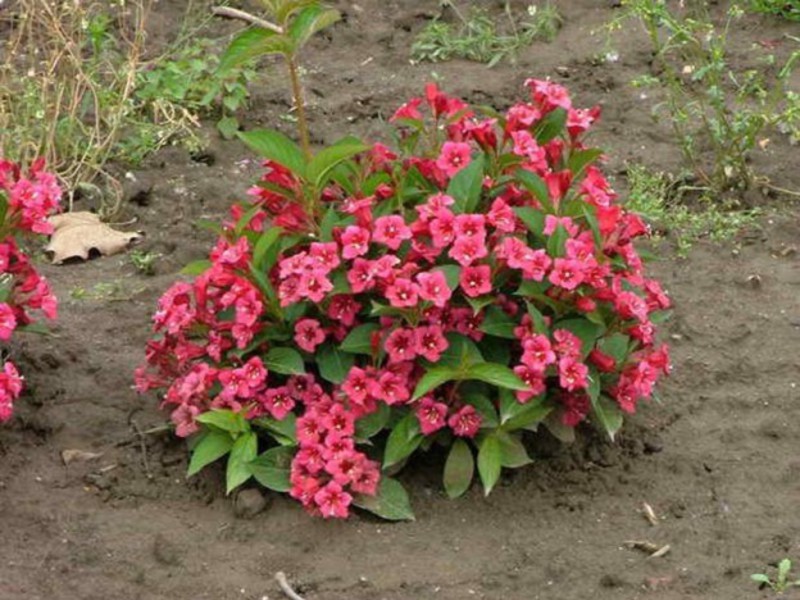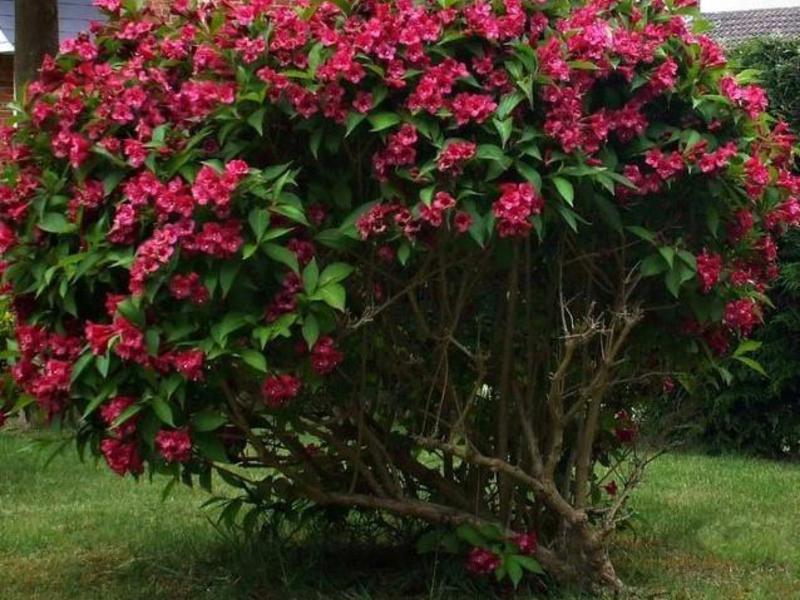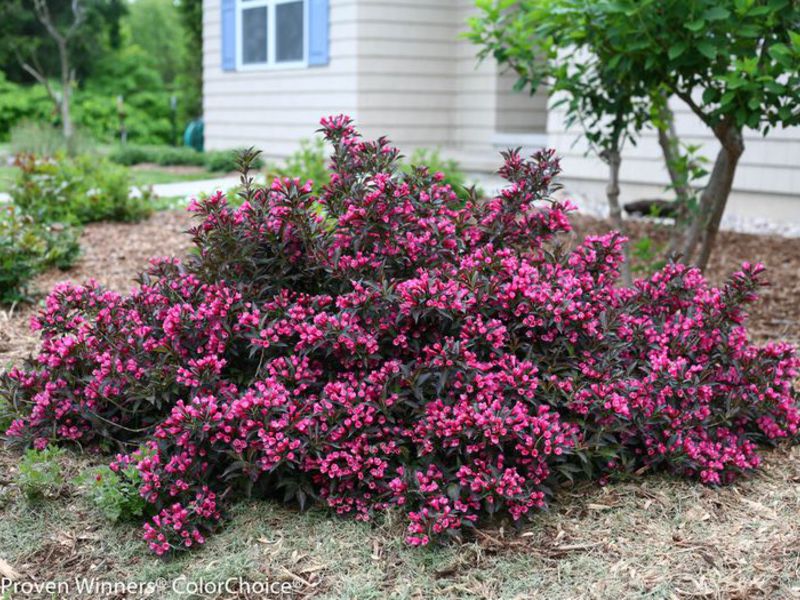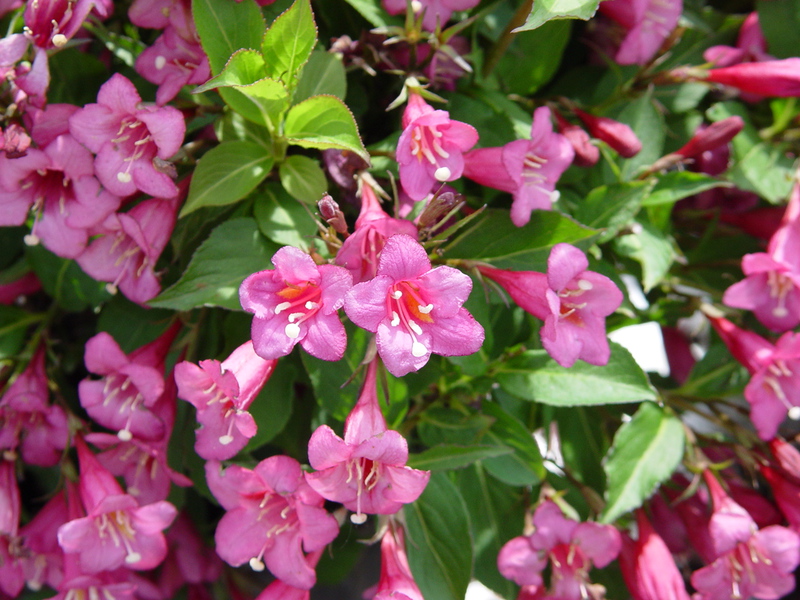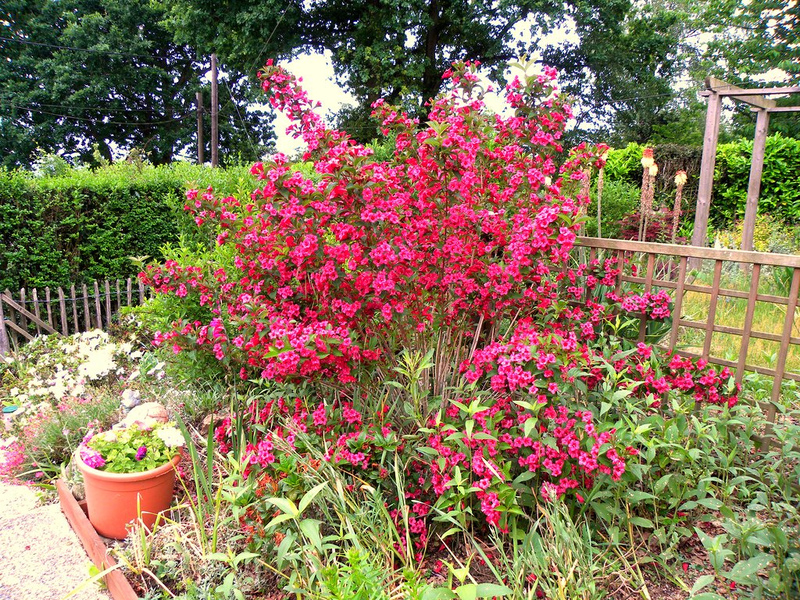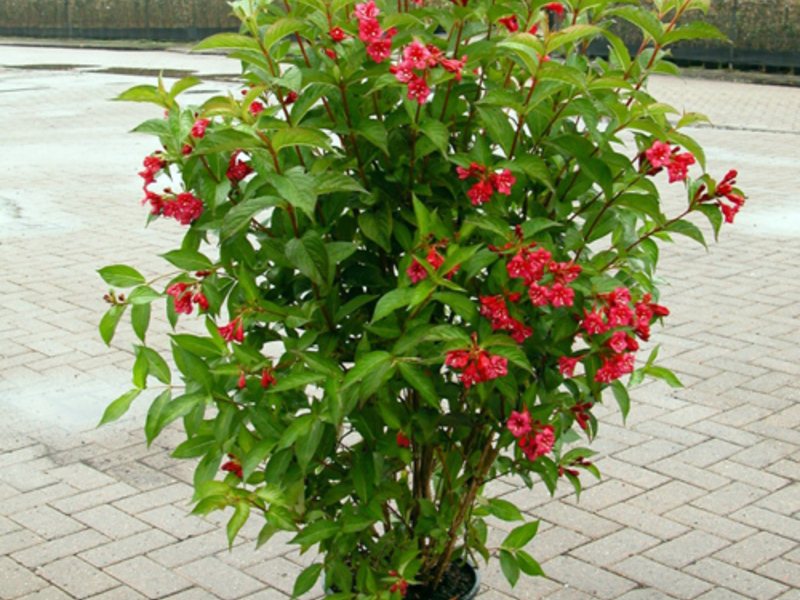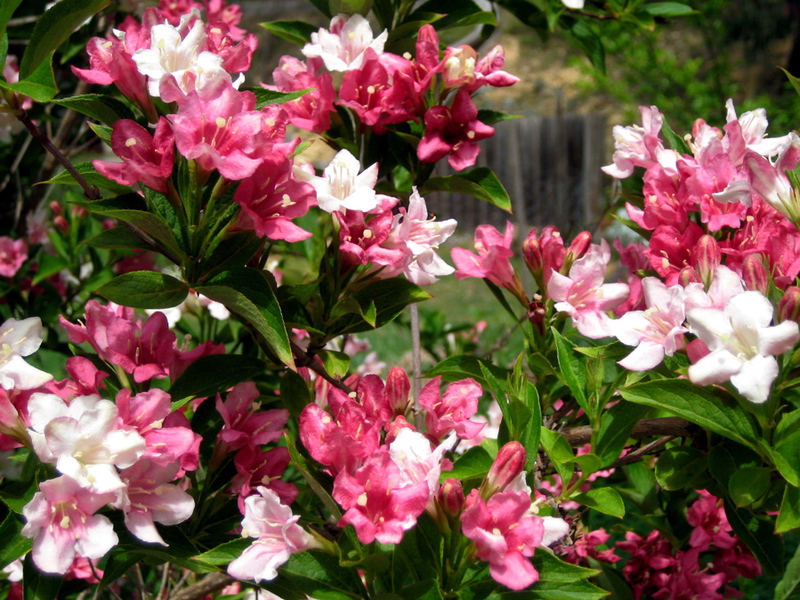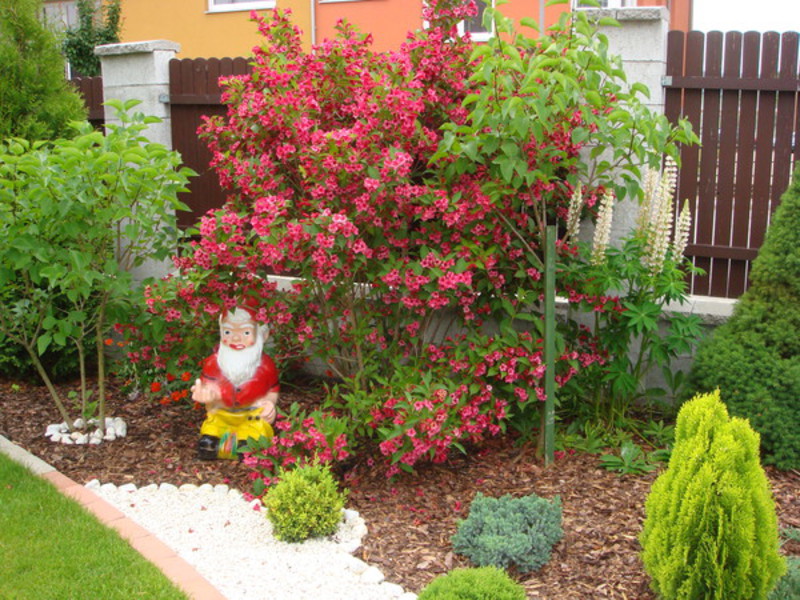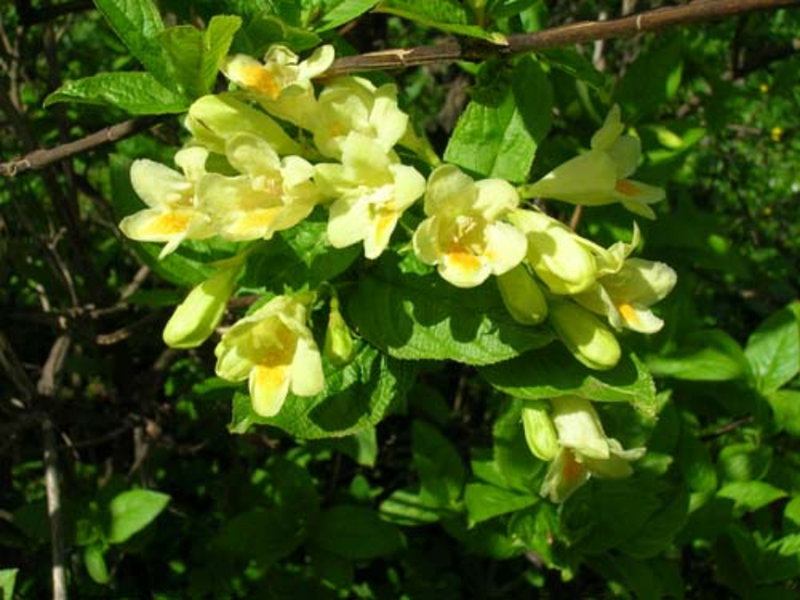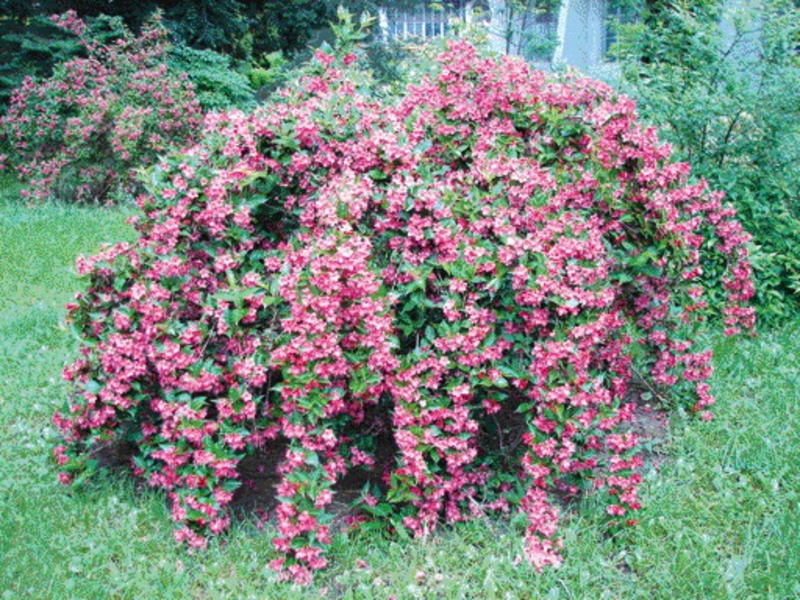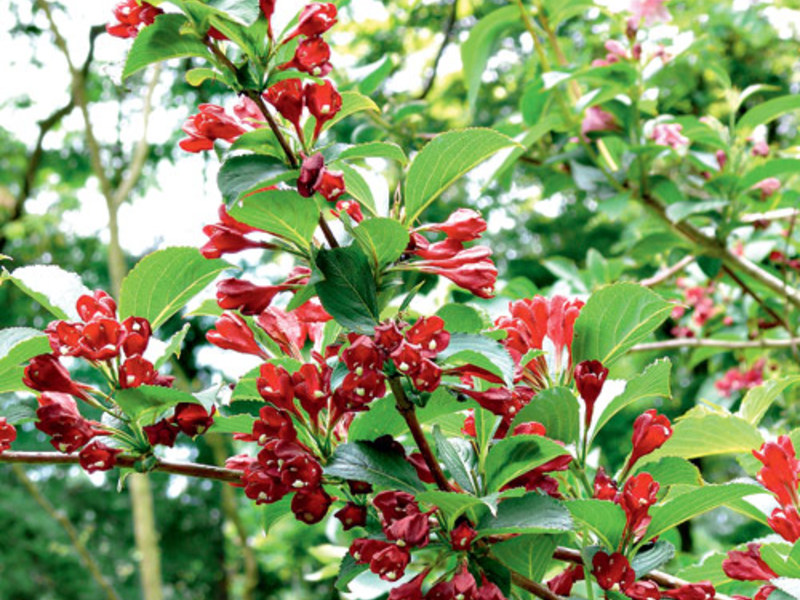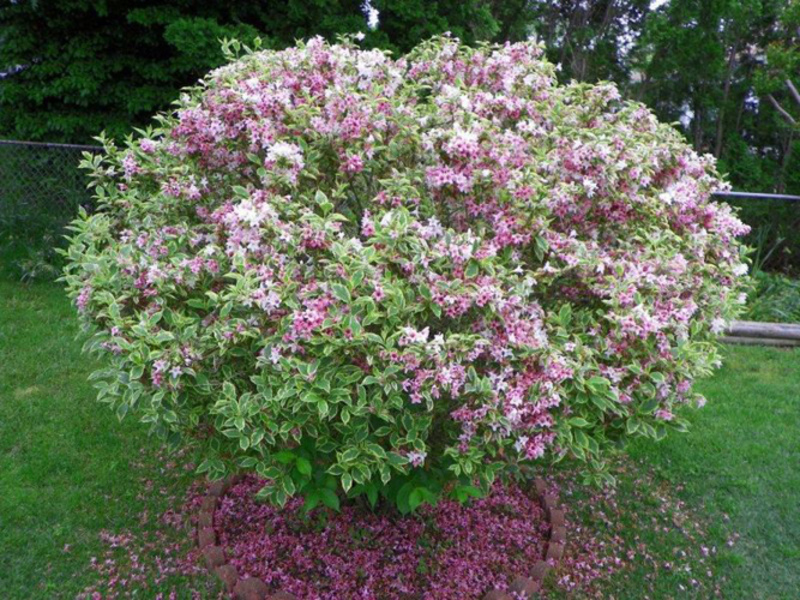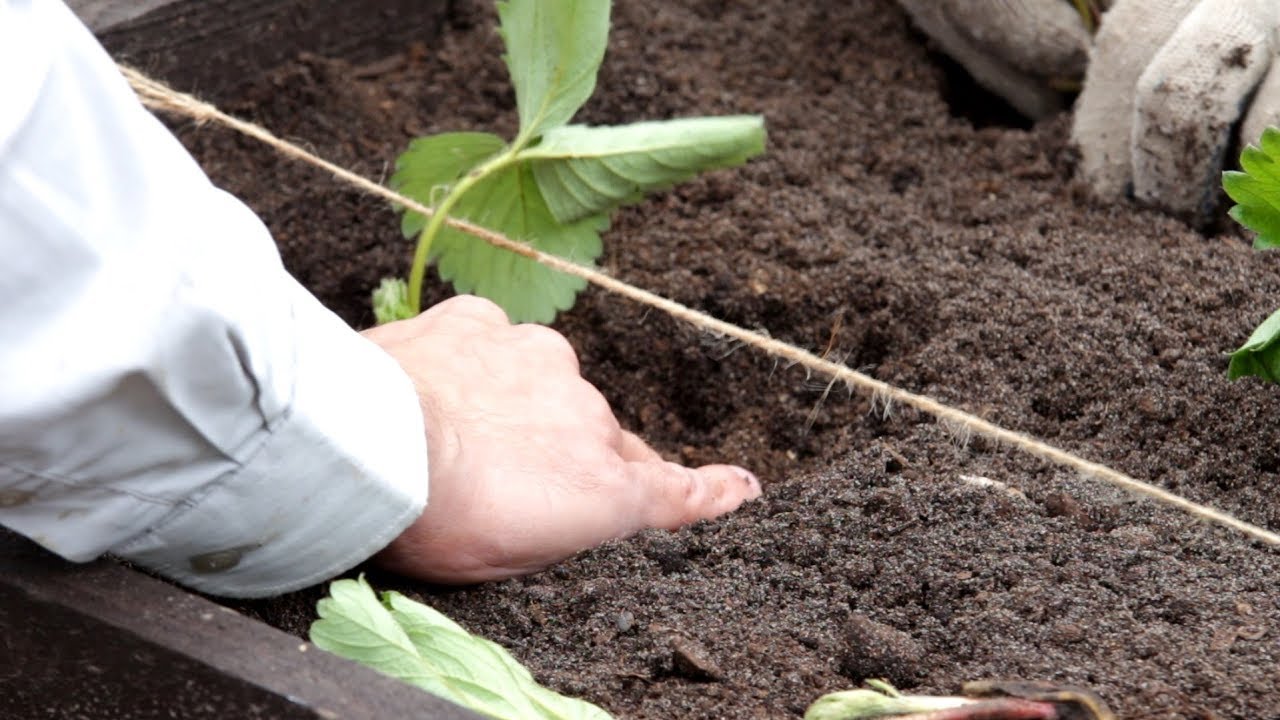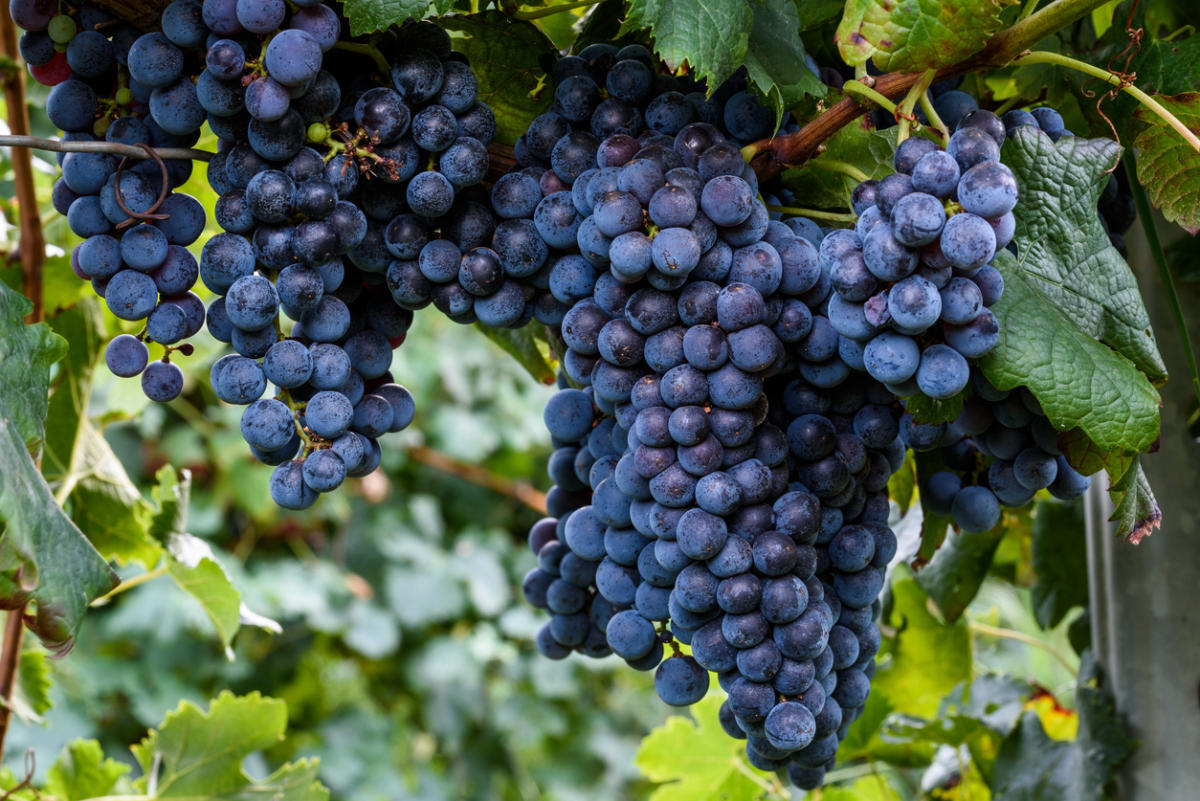It is not necessary to seek help from exotic ornamental plants to make your garden look attractive. Weigela, one of the brightest representatives of the honeysuckle family, can help you with this. You will have the opportunity to enjoy the beauty of this deciduous shrub twice a year: in spring and late summer you can admire its various bell flowers in pink, red, cream, yellow and white shades.
The originality of weigela is given by the fact that, depending on the season, its flowers are painted in different shades. Recently opened corollas are pale in color, but they become more intense over time.
Content
Description
During the growing season weigela forms an erect stem, which lacks stolons - long underground lateral shoots that form shoots. The original appearance of the leaves is given by serrated edges, they themselves are elongated with a pointed tip, reach 12 cm in length. They are located opposite each other, rising on very small petioles, with the onset of autumn they begin to fall off.
In weigela, in very rare cases, single inflorescences, basically there are several of them - 3-7. Most of them are formed on young, elongated and leafy shoots, their formation occurs in the axils of the upper leaves. It is characterized by a rich color range, which can include white, creamy yellow, pink, purple, dark red shades. It is an excellent honey plant. The corolla grows tubular-bell-shaped, reaches a length of 2-4 cm, in some species it can reach 5 cm.
The seed capsule has an unusual structure, which formed by two leaves... Despite the small size of the seeds, a large number of them are formed every season. The first flowers bloom in early May, they are quite numerous. The flowering period is 15-25 days. If weigel is provided with appropriate care, then at the end of summer you can wait for re-flowering, although the number of inflorescences will be less. For the second time, inflorescences are formed on the shoots of the current year.
Types and varieties
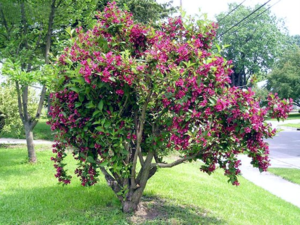 The first acquaintance of the inhabitants of Europe with this plant took place when the flowering weigela was brought here, which is most widely represented in Korea, North and East China... This happened back in 1845, when she came to England thanks to the efforts of the Scottish botanist and traveler Robert Fortune. Gradually, as Japan began to acquaint other countries with its culture every year, other plants of this species began to appear. Now the genus Weigela includes about 15 species and more than 100 varieties.
The first acquaintance of the inhabitants of Europe with this plant took place when the flowering weigela was brought here, which is most widely represented in Korea, North and East China... This happened back in 1845, when she came to England thanks to the efforts of the Scottish botanist and traveler Robert Fortune. Gradually, as Japan began to acquaint other countries with its culture every year, other plants of this species began to appear. Now the genus Weigela includes about 15 species and more than 100 varieties.
Blooming species (lat.W. Florida)
Today this species is known to most experienced florists, because they can be found more often than others in botanical gardens in many countries of the world. Of the features, it is worth highlighting their large sizes: the bushes reach 2-3 m in height, and 3.5 m in width.In adult specimens, the branches begin to bend, forming a kind of arch near the ground... This variety best tolerates cold weather, but it demonstrates frost resistance only in the southern regions; in the northern territories, it usually freezes over.
Hybrid species (lat.W. hybrida)
This variety appeared thanks to the previous one, which served as the basis for it. The plant includes many garden hybrid forms with a wide range of colors. For florists, hybrids developed as a result of crossing of V. flowering with V. Korean (Latin W. coraeensis) and profusely flowering (Latin W. floribunda) are of great interest. Among them, the most famous are Eva Rathke, Candida, Styriaca and Gustave Mallet. However, in the genus Weigela there are also varieties that do not differ in impressive sizes.
Weigela Middendorf (lat.W. Middendorffiana)
This kind of weigela is rather small, grows up to 150 cm in height... Its natural habitat is North China, Japan and the Far East. Favorite places of its growth are undergrowth of coniferous forests. Due to the creamy yellow shade of the flowers, this variety of weigela has become very popular when growing gardens.
Planting and care in the open field
Difficulties with cultivation in our latitudes are due to the fact that the usual habitat for weigela is more warm and humid climate... However, if you show patience and provide appropriate care, then in the conditions of our climate, this shrub will be able to thank you with its beauty.
 The soil. Weigela works best on high-quality soils: they should not only have a loose structure, but also not be waterlogged. It is recommended to prepare a soil mixture based on humus, sand and turf before planting in open ground.
The soil. Weigela works best on high-quality soils: they should not only have a loose structure, but also not be waterlogged. It is recommended to prepare a soil mixture based on humus, sand and turf before planting in open ground.- Landing site. Weigela feels best in an elevated area that is protected from the wind. After all, if moisture stagnates on it or a shadow is present, then you can not wait for abundant flowering. In windy areas, its delicate flowers will not be able to stay on their stems for a long time. Especially light-loving varieties are those in which the leaves have a border. All other weigela varieties can be grown in partial shade conditions.
- Landing. To increase the chances of survival of the weigela bush, it is recommended to use seedlings at the age of 2-3 years. Usually planting is carried out in the spring. To do this, first you need to prepare a pit 50 x 50 cm, which must be filled with a drainage layer 15 cm high, and a layer of fertile soil is already laid on it. You can accelerate rooting by treating the plant with a growth biostimulant. When placing a plant in a pit, care must be taken that the root collar corresponds to the surface level. When the plant appears in a hole, the soil around it needs to be tamped and watered. An effective measure is root zone mulching. In the absence of suitable materials, you can simply fill in small pebbles or pebbles.
- Watering. Considering that the weigela shrub responds well to moisture, it must be watered regularly, especially the high demand for water in spring. It is also necessary to constantly loosen the soil throughout the growing season to avoid compaction.
- Wintering. At the end of flowering, when the last leaves have fallen, the branches must be tied and bent on the ground. Expectations that enough snow will fall in winter are not always justified, therefore, in order to avoid unpleasant surprises in spring, it is recommended to provide shelter for the flower from branches or special materials in autumn.
- Top dressing. Already in the first weeks of spring, you can begin to fertilize the soil by applying complex mineral fertilizer. This measure will stimulate the formation of young shoots, and will also help to grow and bloom better during the warm season.
- Pests. Aphids and caterpillars that feed on leaves are a serious danger to the weigel shrub.Therefore, it is necessary to regularly inspect the plants in order to identify "uninvited guests" in time and take measures to combat them. Excellent results can be achieved by treating the weigela bushes with an insecticidal solution, and it must be repeated after 5-7 days.
Pruning
Weigela shrub care begins in early spring, when remove frozen branches... In the future, pruning is carried out after the end of flowering. To do this, in faded branches, you need to remove parts of the shoot to a developed bud. In addition, thin, underdeveloped growths are subject to removal. As a result of pruning, only the highest quality shoots should remain.
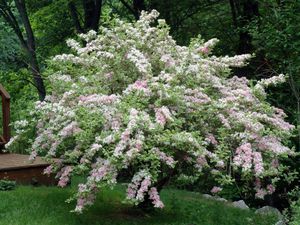 To give the correct shape to the crown of the weigela, pruning should be carried out at least 2-3 times per season;
To give the correct shape to the crown of the weigela, pruning should be carried out at least 2-3 times per season;- Young shrubs deserve special attention, in respect of which only sanitary pruning should be carried out. To do this, you need to timely detect dry and damaged branches and remove them;
- Caring for mature shrubs requires periodic branch removal every 3-4 years. To do this, you need to cut off three-year-old branches, and the rest by a third of the length.
Reproduction
You can get new weigela bushes for use in landscape design by sowing seeds... Their germination percentage is quite high, however, plants rarely grow from seeds of hybrid varieties, to which the varietal properties of the parents are transferred. Therefore, they often have an original shade of flowers, sizes, etc. In this regard, many growers prefer the method of propagation from cuttings.
- after waiting for the flowering of the weigela shrub, which is usually observed in June, they begin to harvest young shoots 15-25 cm long;
- all leaves must be removed from them except for the top ones. A good effect is obtained by treating the end of the shoot with a root formation stimulator;
- then they are placed in a container with peat or ground, which should be in the shade.
Rooting usually occurs in 1-1.5 months. As a rule, only specimens begin to bloom. at the age of 2-3 years.
Use in landscape design
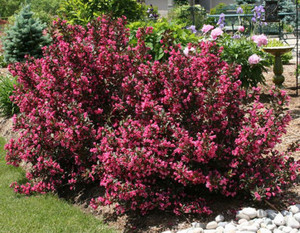 Quite often, weigela is used for decorative purposes, because it attracts not only with unforgettable flowering, but also with decorative leaves. Most often, spireas are chosen as neighbors for her, which bloom at the same time. Also she goes well with lilacs: on the basis of these plants, you can create a wide variety of flower arrangements in landscape design.
Quite often, weigela is used for decorative purposes, because it attracts not only with unforgettable flowering, but also with decorative leaves. Most often, spireas are chosen as neighbors for her, which bloom at the same time. Also she goes well with lilacs: on the basis of these plants, you can create a wide variety of flower arrangements in landscape design.
A wonderful company of blooming weigela can be hydrangeas, the flowering of which begins after the weigela. You can make the flower bed where the weigela grows more original if you plant euonymus, barberry, tall ornamental grasses and cereals there.
If there is a large enough area, you can organize a group planting, including 3-5 shrubs of different or identical varieties, for example, Bristol Ruby. Mixborders made from weigela and herbaceous flowering plants can make the site more attractive. As the latter, you can plant poppies, decorative bows, cinquefoil or soapwort.
Conclusion
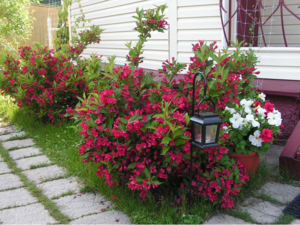 Weigela seems to be an extraordinary plant, which is difficult to pass by, knowing how attractive it will stop at the time of flowering. Many flower growers are not stopped in their desire to grow her on their site, even the fact that she does not tolerate winter cold.
Weigela seems to be an extraordinary plant, which is difficult to pass by, knowing how attractive it will stop at the time of flowering. Many flower growers are not stopped in their desire to grow her on their site, even the fact that she does not tolerate winter cold.
This ornamental plant stands out for its varied color palette, which is fully revealed in June, when the first flowers open. The number and saturation of inflorescences largely depends on the state in which the plant approaches this phase. Therefore, you need to take care of him, starting in spring. It is in the first days of May that fertilizers begin to be applied so that the weigela can gain enough strength for flowering. But she also requires attention in the fall, when she needs to carry out pruning.
